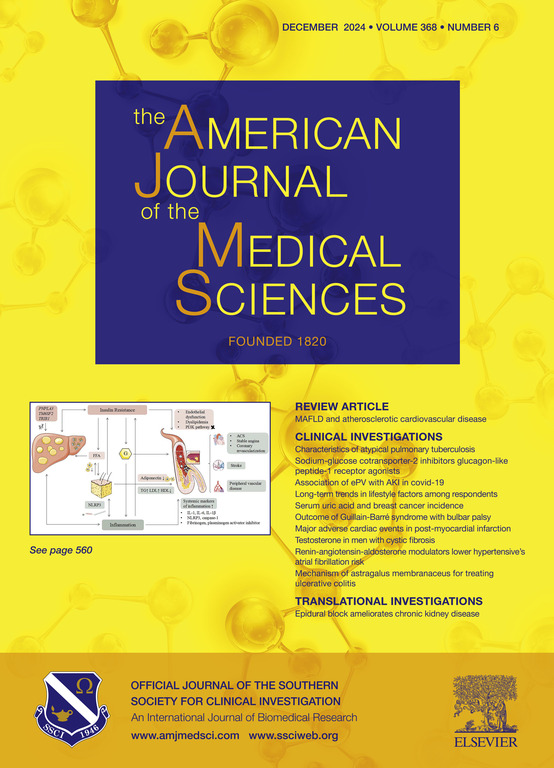COPET研究发现,生物量暴露作为COPD病因型的临床相关性。
IF 1.8
4区 医学
Q2 MEDICINE, GENERAL & INTERNAL
引用次数: 0
摘要
目的:发现COPD也可以在非吸烟者中发展,这导致了对吸烟以外的病因的进一步调查。本研究评估了吸烟和/或生物质燃烧烟雾暴露(BBS)与COPD患者的人口学、临床和预后特征之间的关系。方法:回顾性分析来自COPET研究的1129例稳定期COPD患者。患者分为三组:COPD-B组(n = 52),其中包括单纯的BBS患者;COPD-C组(n = 634),包括完全吸烟的患者;COPD-BC组(n = 443),包括BBS和吸烟的患者。结果:患者平均年龄65.8±9.1岁,男性占87.4%。COPD-B组的年龄(p = 0.001)、BMI (p = 0.001)、女性患者比例(p < 0.001)、FEV1/FVC比(p = 0.014)、酸性粒细胞计数(p < 0.001)、ADO评分(p < 0.001)、频繁加重患者比例(p = 0.013)显著高于COPD-C组和COPD-BC组。胸部CT扫描显示,COPD-BC组支气管扩张和肺气肿的发生率高于COPD-B组和COPD-C组(p< 0.001)。结论:本研究强调了吸烟和BBS在COPD患者的临床和影像学上的显著差异,这可能会严重影响COPD结局,包括恶化和预后。本文章由计算机程序翻译,如有差异,请以英文原文为准。
COPET study findings regarding the clinical relevance of biomass exposure as an etiotype in COPD
Purpose
The finding that COPD can also develop in non-smokers has led to further investigations of etiologic causes other than smoking. This study evaluated the relationship between tobacco smoking and/or biomass-burning smoke exposure (BBS) and the demographic, clinical, and prognostic characteristics of individuals with COPD.
Methods
A total of 1129 stable COPD patients from the COPET study were retrospectively analyzed. The patients were divided into three groups: the COPD-B group (n = 52), which included patients who were solely BBS; the COPD-C group (n = 634), which included patients who exclusively tobacco smoking; and the COPD-BC group (n = 443), which included patients with both BBS and tobacco smoking.
Results
The average age of the patients was 65.8 ± 9.1 years, and 87.4 % of them were men. In the COPD-B group, the following factors were significantly greater compared to the COPD-C and COPD-BC groups: age (p = 0.001), BMI (p = 0.001), percentage of female patients (p < 0.001), FEV1/FVC ratio (p = 0.014), eosinophil count (p < 0.001), ADO score (p < 0.001), and the proportion of patients with frequent exacerbations (p = 0.013). Thorax CT scans showed that the COPD-BC group had a greater incidence of bronchiectasis and emphysema than the COPD-B and COPD-C groups (p < 0.001).
Conclusions
This study highlights significant clinical and radiological differences among COPD patients based on tobacco smoking and BBS, which may substantially impact COPD outcomes, including exacerbations and prognosis.
求助全文
通过发布文献求助,成功后即可免费获取论文全文。
去求助
来源期刊
CiteScore
4.40
自引率
0.00%
发文量
303
审稿时长
1.5 months
期刊介绍:
The American Journal of The Medical Sciences (AJMS), founded in 1820, is the 2nd oldest medical journal in the United States. The AJMS is the official journal of the Southern Society for Clinical Investigation (SSCI). The SSCI is dedicated to the advancement of medical research and the exchange of knowledge, information and ideas. Its members are committed to mentoring future generations of medical investigators and promoting careers in academic medicine. The AJMS publishes, on a monthly basis, peer-reviewed articles in the field of internal medicine and its subspecialties, which include:
Original clinical and basic science investigations
Review articles
Online Images in the Medical Sciences
Special Features Include:
Patient-Centered Focused Reviews
History of Medicine
The Science of Medical Education.

 求助内容:
求助内容: 应助结果提醒方式:
应助结果提醒方式:


